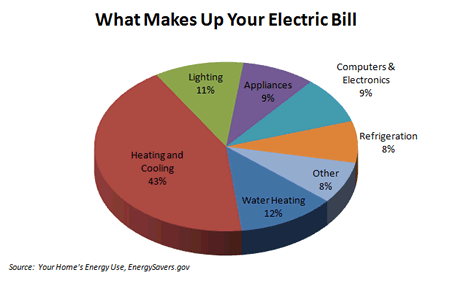This June was the 328th consecutive month with a global temperature above the 20th century average. Middle Tennessee has been experiencing an 8-month trend of higher than average temperatures in what is turning out to be the hottest year on record for North America. These record temperatures have led to some steep electricity bills. If you keep track, this June was likely your highest in years. Let’s take a look at what the average homeowner or renter can do to beat the heat without breaking the bank, while also not forgetting the important climate change connection.
The single most important energy factor that the average homeowner or renter can control during the summer is air conditioning. According to the U.S. Department of Energy, 5 percent of the nation’s electricity is used for household cooling, releasing around 100 million tons of carbon into the atmosphere annually. This comes to about 2 tons per home with an air conditioner. As a percentage of total home energy cost, the average from heating and cooling is around 43 percent, much of which involves empty space. If the national statistics aren’t doing much to motivate you, perhaps the savings will. I recently undertook an experiment in a home that had previously implemented no AC programming and which maintained fairly low set points. Although I am hesitant to make a claim in direct numbers—any such claim would require repeatable results under more controlled conditions—what I can say is that the results were spectacular. The energy savings over the same month of the previous year were dramatic, so much so that I am now a firm believer in programmable thermostats. That is, if they are used correctly.
In one study by Lawrence Berkeley National labs it was found that as many as 90 percent of programmable thermostats are used incorrectly. Another discouraging study by Florida Power & Light found that programmable thermostats used more energy, as homeowners were prompted to set temperatures lower while they were at home. This seems to be largely due to unrealistic ideas about how much energy is actually being saved while away. Although some devices can be somewhat lacking in terms of user friendliness, the initial effort will pay off in spades, as long as the user is correctly informed. Below are some general guidelines from energysavers.gov, although I choose as low/high as I can take:
Summer: 78° F occupied, higher while away. Change to shorts or a skirt before cranking the temperature down. Try not to underestimate the power of acclimation before making a claim about not being able to take it (it is a particularly annoying and predictable male trait to gutturally and proudly complain about it being hot, as if temperature-induced discontent is somehow correlated with being rugged and fertile).
According to energysavers: “By turning your thermostat back 10–15° for 8 hours, you can save about 5–15 percent a year on your heating bill—a savings of as much as 1 percent for each degree if the setback period is eight hours long.”
Winter: 68° F occupied, lower while away. Put on more layers before turning the entire home into an oven. It is crazy to wear short sleeves with snow on the ground.
Spring/Fall: all off, when possible.
An important concept to keep in mind is that your home loses more energy to its surroundings as the temperature difference increases. So a home cooled to 75° loses more energy on a 90° day than the same home cooled to 78°. This dispels the common misconception that the energy required to cool a home after an 8-hour setback is more than the savings. I have been conducting an experiment using a USB temperature datalogger to determine the intersection of setbacks vs. energy-to-cool. As an example, consider a case when the AC is turned completely off in the morning and is set to engage at 4 p.m. During the recent heat wave, I noticed inside temperatures approaching 88°. By the time the home reaches that temperature, the AC will run at full throttle for hours before again reaching a set point of 78°. There is a limit to the gains achieved by turning the temperature up while away. Stay tuned for more on that one.
Another interesting idea is zoned heating and cooling. Close the doors and vents in rooms that are not being used. It only makes sense to not heat/cool empty space. Think of the attic; most are neither heated nor cooled. Extend the same thought pattern to the entire home. There are fancy systems that can automate zoned heating/cooling via programmable duct valves, but I think turning the lever will suffice.
At the end of the day, it is your mindset that determines your level of energy use. Programmable devices can be a great aid to those already headed down that path, but will do little for those with no understanding of household energy. New equipment is far less valuable than a new way of thinking. So give it a try, and I am betting you won’t look back. And concerning the global connection: I am of the opinion that dramatic occurrences, both on the global and local scale, are a good springboard into environmental issues, if not indeed the best. There is no end to the volume of climate-related data, and we can use that data as motivation. If flooding in Beijing and worldwide drought aren’t enough for you, there is always the electricity bill. One thing is for certain: neither are going to improve without action, now.















